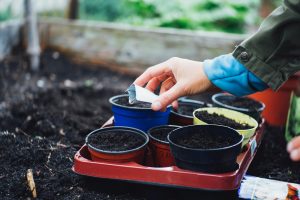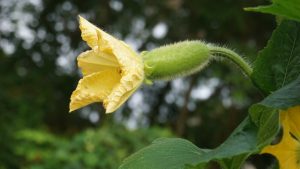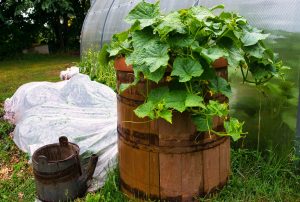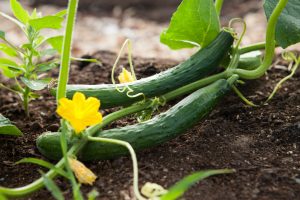Cucumbers are a great addition to any meal, they are juicy, and refreshing and can be used in many different ways, like sandwiches, salads, and snacks. They are also really easy to grow and maintain, making them a great choice for a garden. But, there are several stages that a cucumber seed must go through before it lands in your salad bowl.
The complete life cycle of a cucumber (Cucumis sativus) covers seven well-defined stages. It starts with a humble seed that harvests into delightful fruits. Finally, as the plants die the cycle starts again for new plants to grow in the next year.
7 Cucumber Growing Stages
Stage 1: Germination Stage

The journey of a cucumber begins with the humble seed. Cucumber seeds are relatively easy to germinate, requiring warmth, moisture, and well-draining soil.
- Choose well-drained soil and a warm, sunny spot. Sow seeds ½ inch deep, spacing them 2-3 inches apart.
- Germination: Aim for soil temperatures between 70-85°F. Keep the soil moist but not soggy.
- The seedlings emerge in 5-10 days, ready to greet the world with delicate cotyledons.
Typically, cucumber seeds germinate within 7 to 14 days when provided with optimal conditions. Gardeners can start seeds indoors before transplanting them outdoors or directly sow them in the garden soil once the risk of frost has passed.
During germination, the seed coat splits, and a tiny shoot emerges, seeking light. This early stage is crucial for establishing a strong foundation for the cucumber plant's growth.
Stage 2: Seedling Stage
As the seedling emerges, it begins to develop its first set of true leaves, marking the transition from the germination stage to the seedling stage.
- Seedlings unfurl their first true leaves, eager to soak up the sun. Provide gentle support with trellises or stakes.
- Thinning the ranks: Gently remove weaker seedlings, leaving the strongest 12-18 inches apart for optimal growth.
- Water wisely: Deep, infrequent watering encourages strong root systems. Aim for an inch of water per week unless conditions are exceptionally dry.
The young cucumber plants need adequate sunlight to encourage healthy growth. Providing a minimum of six hours of direct sunlight or supplementing with artificial light ensures robust and vigorous seedlings.
It's essential to keep the soil consistently moist but not waterlogged during this stage. Well-draining soil helps prevent issues like damping off, a fungal disease that can affect young seedlings.
Also Read: 7 Steps of Garlic Growth Stages: From Planting to Harvesting
Stage 3: Vining Stage
Once the seedlings have matured and developed several sets of true leaves, the cucumber plant enters the vining stage. Cucumber plants are known for their vining habit, and this stage is characterized by the development of long, sprawling vines that require support.
- Vines take center stage, stretching and twining with purpose. Pinch off early blooms to encourage strong vine growth.
- Feeding frenzy: Time for a mid-season boost! Apply a balanced fertilizer to fuel foliage and future flowers.
- Mulch matters: Spread organic mulch around the base of plants to retain moisture, suppress weeds, and regulate soil temperature.
To facilitate upward growth, gardeners often use trellises or stakes to keep the vines off the ground. Providing proper support not only saves garden space but also promotes good air circulation, reducing the risk of diseases.
As the vines grow, the plant begins to develop lateral shoots, which will eventually bear fruit.
Stage 4: Flowering Stage

As the cucumber plant matures, it enters the flowering stage, a critical phase in the development of the fruit.
- Tiny yellow blossoms erupt along the vines, marking the start of cucumber-making magic. Female flowers, with swollen bases, hold the promise of fruit.
- Bee the matchmaker: Attract pollinators like bees and butterflies with companion plants like dill or borage. Hand pollination can also be done gently with a cotton swab.
- Keep an eye out for male flowers: Pinch them off to encourage female flower production and maximize cucumber yield.
Cucumber plants produce both male and female flowers, and pollination is essential for fruit formation. Bees and other pollinators play a crucial role in transferring pollen between flowers, ensuring successful fertilization.
Gardeners can encourage pollination by attracting pollinators to the garden and avoiding the use of pesticides that may harm them. Additionally, planting companion flowers like marigolds can help create a pollinator-friendly environment.
Also Read: Pitaya or Dragon Fruit? Unveil the Differences!
Stage 5: Fruit Setting

Following successful pollination, the cucumber plant enters the fruit-setting stage. This is when tiny cucumbers, often referred to as “baby cucumbers” or “cucumber embryos,” begin to form.
- Baby cucumbers peek from the foliage, swelling with each passing day. Harvest young, when they're about 6-8 inches long and firm to the touch.
- Snip with care: Use sharp pruners to avoid damaging the vines. Regular harvesting encourages continued fruit production.
- Don't let them linger: Overripe cucumbers lose their crispness and flavor. Harvest regularly to enjoy them at their peak.
Cucumber varieties can affect the size, shape, and color of the fruits. Some cultivars produce smooth-skinned cucumbers, while others may have a more textured or spiny surface.
Regular monitoring and care, including the removal of misshapen or damaged fruits, contribute to a bountiful harvest.
Stage 6: Rapid Growth
As the cucumber matures, it enters a phase of rapid growth. During this stage, the cucumber expands quickly, reaching its full size. Adequate water, sunlight, and nutrients are crucial to support the increased demand for energy and resources.
- Diligence in maintaining a consistent watering schedule, providing sufficient nutrients through fertilization, and monitoring for pests and diseases.
- Let nature take its course: Once all fruits are harvested, allow the vines to die back naturally, this helps to enrich the soil for future plantings.
Cucumbers are high-moisture vegetables, so ensuring a well-hydrated plant is key to preventing issues like bitterness or irregular fruit development.
Also Read: Is an Onion a Fruit? Veggie Facts Revealed!
Stage 7: Harvesting Stage

The final stage in the cucumber growing process is harvesting. Cucumbers are typically ready for harvest 50 to 70 days after planting, depending on the variety.
- Signs of maturity include a vibrant color, firm texture, and size appropriate for the specific cultivar.
- Harvesting should be done regularly to encourage continuous fruit production.
- Using pruning shears or a sharp knife, cut the cucumber from the plant, taking care not to damage the vine or nearby fruits.
- Overripe cucumbers can become bitter, so harvesting at the right time ensures a delicious and enjoyable crop.
Conclusion
From the tiny seed to the crisp, green cucumber on your plate, the journey of this versatile vegetable is a journey. Understanding and appreciating each phase of the cucumber growing process is crucial for successful cultivation.
By providing the right conditions, care, and attention at each stage, gardeners can ensure a bountiful harvest of fresh, homegrown cucumbers to enjoy in salads, pickles, and a variety of culinary delights. Happy gardening!
























